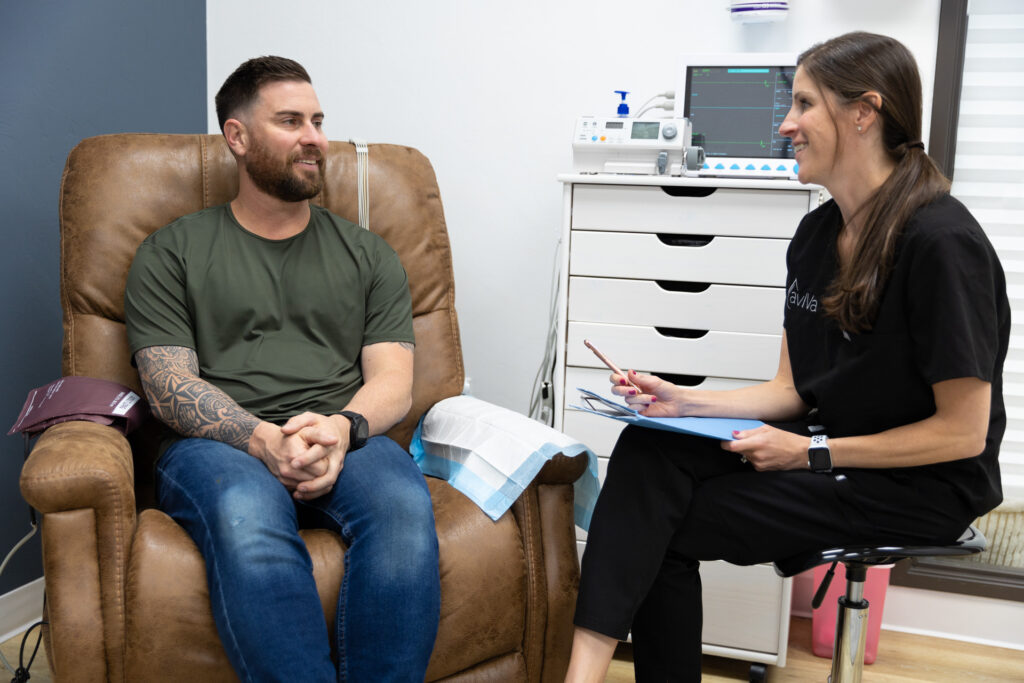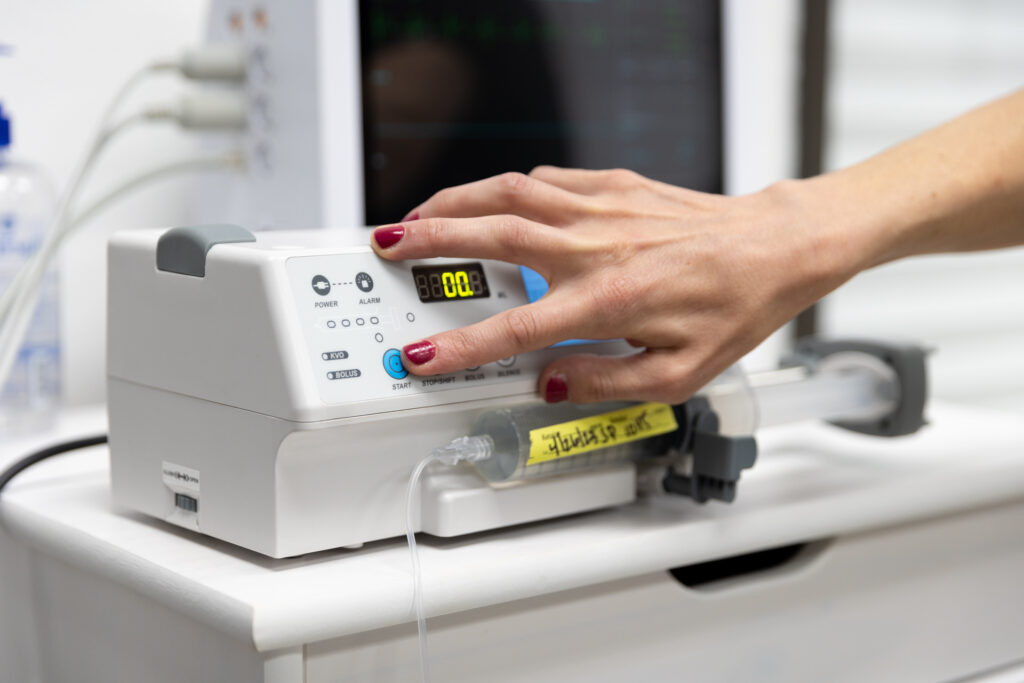Kick start your mental health at avIVa Infusions
Ketamine for PTSD Treatment
What doctors are calling a promising, novel therapy for PTSD and anxiety.
At avIVa Infusions, we are proud to offer the latest in mental health treatment options.
At avIVa Infusions, we are proud to offer the latest in mental health treatment options. In addition to high levels of safety standards and patient care, avIVa Infusions utilizes ketamine infusion therapy for the treatment of PTSD, as well as other mood disorders like depression, OCD, and anxiety.
Our mission statement at avIVa Infusions is to provide personalized, high-quality management options for people struggling with treatment-resistant conditions. Ketamine infusions have proven to be a powerful and rapid treatment for PTSD and other mental health conditions.
Treatment Details
Consultation Required?
Yes
Downtime:
Unable to drive for 12 hours
Sessions Needed:
6 loading doses
Results Duration:
One infusion booster every 4-12 weeks
What it Treats
Treatment-resistant depression
Suicidal ideation / suicidal thoughts
Insomnia
Lack of appetite
Trouble focusing
Feelings of emptiness, sadness, and hopelessness
Loss of interests in hobbies
Ketamine therapy for PTSD in Green Bay
Effective Against PTSD
Ketamine for PTSD treatment offers fast and efficient relief from the symptoms of anxiety disorders or mental health conditions, with up to 75% of patients reporting a positive response to just a single ketamine infusion.
Fast Relief
With traditional treatments for PTSD, it can sometimes take weeks or even months before you experience symptom relief. Ketamine is an exciting new treatment option because in some cases it can provide relief from PTSD symptoms within days or even hours.
Minimal Side Effects
Compared to traditional methods of treating PTSD, ketamine infusions come with minimal side effects, if any. Your avIVa provider will review all potential physical and/or mental effects of ketamine infusions to ensure you are fully educated before treatment begins.

Lifestyle Changes & Ketamine Therapy
The Path to Healing from PTSD
There are certain lifestyle changes that can be made that are very useful when combined with a treatment like ketamine infusion.
Follow Your Treatment Plan
Though it takes some time–months, at times–to be effective, therapy and medication can help your symptoms. Try to have patience, and be sure to communicate with your healthcare professional to make sure you’re getting the best treatment options you can.
Educate Yourself
Learn what you can about your condition. Understanding is the first step to healing. Read up on your condition so you can develop coping strategies that have worked for others.
Avoid Unnecessary Drugs or Alcohol
Sometimes people with PTSD grow frustrated when nothing seems to touch their symptoms, and as a result will turn to substance abuse. Alcohol and drugs will only worsen symptoms over time.
Prioritize Self Care
Make sure you’re making time for yourself. Self-care is vital. Get enough sleep, eat healthy (when you can), and try to spend at least 30 minutes a day devoted to some sort of physical exercise, like walking, jogging, or cycling.
Find Support
Don’t shy away from support groups. No one knows your condition better than you do, but there are others who have been through similar situations. These individuals can be a great comfort to you as you continue your treatment.
Frequently Asked Questions
- What is PTSD?
-
PTSD (post-traumatic stress disorder) is an anxiety disorder that a person can develop after a traumatic or life-threatening event. The affected person does not have to be directly involved, because even the shock of witnessing some events is enough to kickstart the symptoms of PTSD.
The most commonly reported symptoms of PTSD are flashbacks, low self-esteem, insomnia, and persistent unpleasant emotions. You may lose your memory of the traumatic event, or you may instead have intrusive thoughts about it. PTSD comes in many forms and affects everyone differently.
While outlook can be grim when suffering from PTSD, it can be treated and the symptoms can be lessened. There are lots of options available for treatment including innovative new therapies like ketamine infusion.
- What are the symptoms of PTSD?
-
The effects of PTSD involve a wide range of symptoms. One of the most common symptoms people experience is disruptive flashbacks. These may involve visual hallucinations of the situation that traumatized you. Daydreaming about the event is also common, as well as nightmares that wake you up at night. People who suffer from flashbacks describe them as being so vivid that they feel like they are actually back in the moment that caused their trauma.
Another key symptom is avoidance. This means you may try to avoid going near a place that triggers your PTSD symptoms. If someone reminds you of the trauma, a police officer for example, then you may go out of your way to avoid them. You may also refuse to talk to other people about your painful experiences, although this can block your pathway toward healing.
Other symptoms of PTSD include the following:
- Feelings of guilt and shame
- Nausea or a lack of appetite
- A sense of constantly being on edge
- Irritability or angry outbursts
- What causes PTSD?
-
PTSD is caused by some type of traumatic event that triggers changes in your brain, altering its overall function. Like most mental health conditions, researchers are still trying to figure out exactly what leads to the development of PTSD. That said, it seems that parts of the brain associated with memory and emotion (like the prefrontal cortex and amygdala) are physically changed by traumatic experiences.
People with PTSD also tend to have higher levels of stress hormones like cortisol and norepinephrine. Essentially, your brain can suddenly trigger the fight-or-flight response if it senses anything that reminds you of the traumatic event.
Traumatic events can come in many different shapes and forms, but the most common examples include some of the following:
- Childhood abuse
- Sexual abuse
- Domestic violence (whether physical, verbal, or sexual)
- Physical assault
- Witnessing a criminal act
- Car accidents
- Natural disasters
- The loss of a loved one
- How do I know if I need treatment for my PTSD?
-
If you find that your PTSD symptoms are preventing you from living a normal life, then there is no shame in reaching out for help. For starters, you aren’t alone. Roughly 7% of American adults have experienced PTSD in the past, and up to eight million American adults live with it each year.
What to expect when seeking professional help:
- Physical Exam: Your healthcare professional will check to see if there are any underlying medical conditions/problems that are causing your symptoms.
- Psychological Evaluation: You will meet with your healthcare professional and discuss symptoms and any traumatic events that you have been through that might be triggering symptoms.
- Diagnostic and Statistical Manual of Mental Disorders (DSM-5): A manual published by the American Psychiatric Association that includes a set of criteria generally seen in patients with PTSD.
Those diagnosed with PTSD typically have experienced or witnessed an event that threatened serious bodily harm or, in some cases, death. The event is typically experienced firsthand, but not exclusively. It’s possible to develop the disorder through witnessing something or hearing harrowing details of a traumatic event.
If PTSD symptoms are keeping you from living a normal life, it may be worth considering treatment.
- What treatments are there for PTSD?
-
PTSD symptoms take a major toll on both the mind and the body, and if you’re finding it difficult to carry out everyday tasks or find that you’re isolating yourself from loved one, consider the treatments available to you. Finding a treatment that works can help give you back control over your life, as well as teach you:
- How to cope with resurging symptoms
- How to properly address your condition and its symptoms
- How to maintain positive thinking and self-confidence
- How to treat other problems that come along with witnessing a traumatic event, like depression, substance abuse, and/or anxiety
The most common treatments for PTSD include:
- Medication
- Psychotherapy
- Ketamine Infusions
Medications
The most common for combatting the symptoms of PTSD include paroxetine (Paxil) and sertraline (Zoloft).
Psychotherapy
Also referred to as talk therapy. This includes exposure therapy, cognitive therapy, and eye movement desensitization and reprocessing (EMDR).
Ketamine Infusions
A new and effective treatment for the symptoms of PTSD is ketamine infusions, where research shows a roughly 75% success rate for relief.
- How can I help a loved one with PTSD?
-
It’s important to have patience. Their symptoms deeply affect them, and it could be that they are acting like a completely different person than the one you know. They may be more irritable, or isolating themselves in ways they never did before. It may be difficult to hear about the trauma they experienced, or you may feel guilty for not being able to help them through this time in their life.
While you may not be able to magically cure them, there are ways you can help ease some of their discomfort:
- Educate yourself. Read up on PTSD, and familiarize yourself with its symptoms. The more you know the more you can help your loved one.
- Be able to recognize the symptoms. It is important to remember that withdrawal and isolation can be indicating factors of larger, underlying issues. Give them the space they need, but remind them that you are there when they are ready for help.
- Offer to keep them company during their appointments. Not only will you bring them comfort through your company, but you will also be able to become more familiar with the condition itself.
- Listen. One of the greatest things you can do is simply offer an ear for them to vent. Be careful not to push too hard if they are hesitant. They will come to you when they are ready.
- Don’t be afraid to reach out for help. If you are having a difficult time, talk to your doctor or a healthcare professional. They may refer you to a therapist so that you can help manage your own stress.
- Is ketamine therapy painful?
-
Ketamine therapy is not painful. While this treatment for PTSD does require a needle, the needle is small, insertion is fast, and patients report minimal-to-no discomfort.
Get Started
Tell us more about you and your needs using our Virtual Consultation Tool.
Input your concerns, and we’ll provide custom treatment recommendations for your unique needs.


